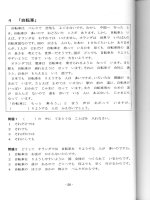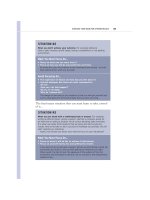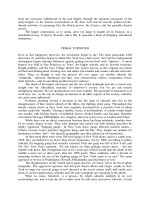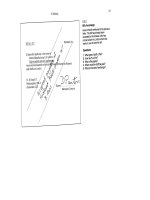Rapid GUI Development with QtRuby phần 6 pptx
Bạn đang xem bản rút gọn của tài liệu. Xem và tải ngay bản đầy đủ của tài liệu tại đây (507.75 KB, 12 trang )
F
ridays
CHAPTER 5. TAKE THE PLUNGE SIGNALS AND SLOTS 54
@button
clicked() setText(const QString &)
Label Text
@label
Figure 5.14: Slot Connection with mis-matched arguments
ment is discarded.
Howe
ver, the opposite is not true:
@button = Qt::PushButton.new
@
label = Qt::Label.new
# This doesn't work
Qt::Object::connect( @button, SIGNAL(
'clicked()'
),
@label, SLOT(
'setText(const QString &)'
) )
The above code generates the following error which is displayed dur-
ing runtime:
QObject::connect: Incompatible sender/receiver arguments
Qt::PushButton::clicked() > Qt::Label::setText(const QString &)
Disconnecting Signals and Slots
Signal/slot connections can also be disconnected via the same syn-
tax:
@button
= Qt::PushButton.new
@bar = Qt::StatusBar.new
Qt::Object::connect( @button, SIGNAL(
'clicked()'
),
@bar, SLOT(
'clear()'
) )
# Perform a disconnection
Report erratum
BOOKLEET ©
F
ridays
CHAPTER 5. TAKE THE PLUNGE SIGNALS AND SLOTS 55
Qt::Object::disconnect( @button, SIGNAL(
'clicked()'
),
@bar, SLOT(
'clear()'
) )
Tying it all together
The power with signals and slots lies in their flexibility. Signals can
be used fr o m existing widgets, or created in new widgets. New slots
can be made in custom widgets that mask internal child widgets.
Most importantly, these signals and slots cross widget boundaries
and allow us to encapsulate child widgets through a parent widget
interface.
Let’s see it in action. Consider this class:
class MyTimer < Qt::Widget
signals
'tripped_times_signal(int)'
slots
'timer_tripped_slot()'
def initialize(parent)
super(parent)
@timer = Qt::Timer.new(self)
@label = Qt::Label.new(self)
@tripped_times = 0
connect(@timer, SIGNAL(
'timeout()'
),
self, SLOT(
'timer_tripped_slot()'
))
# Make the timer trip every second (1000 milliseconds)
@timer.start(1000)
end
def
timer_tripped_slot()
@
tripped_times += 1;
@label.setText(
"The timer has tripped "
+
@tripped_times.to_s +
" times"
)
Report erratum
BOOKLEET ©
F
ridays
CHAPTER 5. TAKE THE PLUNGE SIGNALS AND SLOTS 56
MyTimer < Qt::Widget
The Timer
@label
timer_tripped_slot
@timer
tripped_times_signal(int)
timeout()
setText()
emit
Figure 5.15: Custom Widget with Signals and Slots
emit tripped_times_signal(@tripped_times)
end
end
In t
his example, we create a Qt::Timer that gets activated every second
(1000 milliseconds). Each time @timer is activated, its timeout( ) signal
Qt::Timer is a very convenient class for repeatedly c alling a
slot
at a certain frequency. In most cases, a
Qt::Timer can
be accurate to 1 millisecond.
is emitted. We’ve connected the timeout( ) signal to the timer_tripped_slot( )
slot. This slot updates the text on the label to reflect the total num-
ber o f times the timer has tripped. The slot also emits the
tripped_times_signal( ),
telling how many times the timer has tripped. The MyTimer does not
make use of the tripped_times_signal( ) signal, but an external class
might use that information by connecting the signal to one of its
slots. We highlight this code example on Figure 5.15 .
Report erratum
BOOKLEET ©
F
ridays
CHAPTER 5. TAKE THE PLUNGE SLOT SENDERS 57
5.6 Slot Senders
Sometimes during a slot it is useful to know how the slot got started.
The send
er( ) returns the Qt::Object which was responsible for the slot
call. The sender( ) method only works for a slot when it was activated
by a signal—manually calling the slot does not work.
Consider the following code:
require
'Qt'
class SignalObject < Qt::Object
signals
'mySignal()'
def initialize(parent=nil)
super(parent)
end
def trigger
emit mySignal()
end
end
class
SlotObject < Qt::Object
slots
'mySlot()'
def initialize(parent=nil)
super(parent)
end
def mySlot
puts
"Slot called by #{sender.class}"
end
end
sig = SignalObject.new
Report erratum
BOOKLEET ©
F
ridays
CHAPTER 5. TAKE THE PLUNGE SUMMARY 58
slot = SlotObject.new
Qt::Object::connect(sig, SIGNAL(
'mySignal()'
),
slot, SLOT(
'mySlot()'
) )
Now look at the effects on the sender( ) method in a slot when it’s
activated by a signal:
irb(main):001:0> sig.trigger
S
lot called by SignalObject
versus when it’s called manually:
irb(main):002:0> slot.mySlot
Slot called by
NilClass
5.7 Summary
• Custom widgets should inherit from base class Qt::Widget.
• Wid
gets have a two-dimensional geometry. This geometry can
be set manually or handled a utomatically through layouts.
• Widgets define signals that are emitted when certain spon-
taneous events occur. They also define slots which are reac-
tionary methods that can be connected to these signals.
• Widget slots can use the sender( ) method to find out how they
w
ere
activated.
Report erratum
BOOKLEET ©
F
ridays
Chapter 6
Sink or Swim
At t his point, we’ve really tackled most of the concepts needed t o
make a robust Qt Ruby application. However, there’s still a bit more
to do.
6.1 Event Methods
Our earlier discussion about event driven programming led into the
conce
pt of signals and slots. But there’s more to events than just
signal emission. Remember, in the GUI world, events are the under-
lying paradigm of the program operation.
It turns out that many of the these GUI events a re so important that
they are handled in a much more direct way than just as an emitted
signal. Instead, there are event methods which are directly called
within a Qt::Wi dget object.
Qt::Widget based classes have many specialized
event methods for handling most of the
common events that can happen in a GUI
application. See Appendix
A, on page 88 for
an ov
erview.
One event from start to finish
For the moment, let’s look at one type of event: the mouse press.
When a mouse button is pressed the following series of things hap-
pens:
Obviously, the m o use pr e s s event has to happen within the
geometry of our application . Cl i cking the mouse elsewhere
on t he scre e n has no effect on our program.
1. The window system recognizes the mouse press, and passes
the mouse information to the QtRuby application.
2. The application uses the information to create a Qt::MouseEvent
object, containing information about which button was pressed
a
nd
t
he
location of the mouse when the button w as pressed.
BOOKLEET ©
F
ridays
CHAPTER 6. SINK OR SWIM EVENT METHODS 60
Mouse
Click
Qt::Application
Qt::MouseEvent
Qt::Widget
mousePressEvent
Figure 6.1: A Mouse Event delivered to a Qt::Widget
3. The application then determines which widget the mouse was
directly on top of when the button was pressed. It dispatches
the Qt::MouseEvent information to this widget’s mousePressEvent( )
method.
4. The widget chooses what do to a t this point. It can act on this
information, or can ignore it. If it ignor es the information, the
Qt::MouseEvent then gets sent on to the parent of the widget, to
b
e ac
ted upon.
5. The Qt::MouseEvent continues up the hierar chy until a widget
a
c
c
e
pts the event, or it reaches the top level and cannot go any
further.
Report erratum
BOOKLEET ©
F
ridays
CHAPTER 6. SINK OR SWIM EVENT METHODS 61
An Example of Qt::MouseEvent
require
'Qt'
class MouseWidget < Qt::Widget
def initialize(parent=nil)
super(parent)
@button = Qt::PushButton.new(
"PushButton"
, self)
@layout = Qt::VBoxLayout.new(self)
@layout.addWidget(@button)
@layout.addStretch(1)
end
def
mousePressEvent(event)
if(event.button ==
Qt::RightButton)
Q
t::MessageBox::information(self,
"Message"
,
"You clicked the widget"
)
else
event.ignore
end
end
end
app = Qt::Application.new(ARGV)
mw
= MouseWidget.new
app.setMainWidget(mw)
mw.show
app.exec
In this example the MouseWidget has implemented the mousePressEv-
ent(
Qt::MouseEvent) method, meaning that it wishes to handle this
mouse event internally (see Figure
6.2, on the next page).
T
he M
o
u
seWidget checks the mouse button t hat was pressed to start
t
he
e
v
ent—if it was the right (as opposed to the left) button, then
Report erratum
BOOKLEET ©
F
ridays
CHAPTER 6. SINK OR SWIM EVENT METHODS 62
Figure 6.2: MousePressEvent Override Snapshot
it pops up a message. Otherwise, it ignores the event, which then
woul
d get passed on to the parent (if there was one).
When creating a custom event method, such as
mousePressEvent( ), it’s important to remembe r that you
are overriding the base class method with your own. If your
goal is no t to replace th e base class functionality, but to
extend it, then you must be sure to call the base c l ass ev e nt
method from within your e vent method.
The mousePressEvent( ) only gets invoked for presses in the empty space
of the MouseWidget, however. Notice that the MouseWidget also con-
tains a Qt::PushButton, but if that Qt::PushButton gets pressed, it has its
own internal handling of the mousePressEvent( ), and the MouseWi dget
never sees a mousePressEvent( ).
More methods
Obviously, ther e a re more event classes than just Qt::MouseEvent.
Qt::Widget also has specialized handlers for these events. We’ve cre-
ated
a chart to overview the event methods and handlers available
in QtRuby in Appendix
A, on page 88
We’ve seen how to create event methods that are invokeded auto-
Report erratum
BOOKLEET ©
F
ridays
CHAPTER 6. SINK OR SWIM EVENT FILTERS 63
matically when certain events happen. Another powerful aspect of
the Qt
Ruby toolkit is the ability to install event filters between objects.
6.2 Event Filters
Event filters allow objects to listen in to and intercept events from
other objects. To create an event filter, we use the installEventFilter( )
method that is part of Qt::Object.
object_to_be_filtered.installEventFilter( intercepting_object )
Wi
th this syntax, all of object_to_be_filtered’s events get sent directly
to intercepting_object’s eventFilter( ).
The
eventFilter( ) method has two arguments, the Qt::Object that is
being filtered and the Qt::Event that was received. With this infor-
mation, the eventFilter( ) method can intercept the event and perform
the de
sired action.
If
eventFilter( ) returns true, the event is considered to have been suc-
c
essfully intercepted. Otherwise, the event will continue to propogate
through the normal event handling chain. We show the event filter
logic on Figure
6.3, on the next page.
Here’s an exa mple of an event filter:
require
'Qt'
class MouseFilterWidget < Qt::Widget
def initialize(parent=nil)
super(parent)
@
button
=
Qt::PushButton.new(
"PushButton"
, self)
@layout = Qt::VBoxLayout.new(self)
@layout.addWidget(@button)
Report erratum
BOOKLEET ©
F
ridays
CHAPTER 6. SINK OR SWIM EVENT FILTERS 64
New
Event
Widget
eventFilter
Filtering widget
yes
Widget
intercept
event?
no
no
Event
Handler
Event
Handler
yes
Figure 6.3: Event Filter Flow
@layout.addStretch(1)
# Override events for the button
@button.installEventFilter(self)
end
def eventFilter(obj,event)
if(obj ==
@button && event.type == Qt::Event::MouseButtonPress)
if(event.button == Qt::RightButton)
Qt::MessageBox::information(self,
"Message"
,
"You right clicked the button"
)
Report erratum
BOOKLEET ©
F
ridays
CHAPTER 6. SINK OR SWIM THE MAIN EVENT 65
return true
end
end
end
end
app = Qt::Application.new(ARGV)
mw
= MouseFilterWidget.new
app.setMainWidget(mw)
mw.show
app.exec
This code installs an event filter on a Qt::PushButton referenced by
@button. The eventFilter( ) method then checks if we’ve received a but-
ton p
ress for the @button and if it’s t he right mouse button, display a
message. Otherwise, event handling o ccurs as normal. This means
that a left button click results in the same thing that would normally
happen—the button accepts the click.
6.3 The Main Event
The event methods we’ve seen so far are specialized event meth-
ods t
hat get called for specific types of events.
Qt::Object also has a
generic event method, which handles the dispatching of the special-
ized events. This method, aptly named event( ), can also be overrid-
den t
o provide customized behavior. Qt::Widget overrides this method
to handle GUI relat ed events.
Thus, the overall logic of a widget’s event handling is as follows:
Which event methods to override is up to you.
The specialized event methods are higher level
and easier to implement, but less flexible than
the low level
event( ).
1. A
new event (Qt::Event) is created, and get s passed to the event( )
method.
Report erratum
BOOKLEET ©









